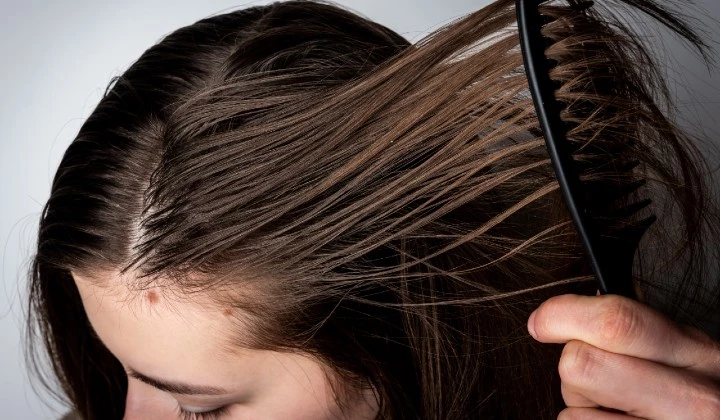Oily Scalp: Why you have itand how to prevent it
Everyone’s scalp naturally produces oil, but sometimes an overproduction may cause conditions such as dandruff. To find out more about what causes greasy hair and tips to reduce oiliness, and therefore, prevent dandruff, keep reading!

Why does our scalp produce oil?
The oil that our scalps produce, also known as sebum, is made to protect and hydrate the hair and scalp. The amount of sebum that each person’s scalp produces depends on a variety of factors, such as hair type and hygiene habits.
Causes of an oily scalp
Causes of excess scalp oil production can be as simple as overwashing the hair or maybe even the type of hair you have. Washing your hair too often can send signals to your scalp that more sebum needs to be produced to keep hair clean. There are several more causes of excess scalp oil production which you might not have considered, keep reading to find out more.
Genetics and hair type
- Your genes can play a big part in how much oil your glands produce, as well as what hair type you have. The curl pattern of your hair will also determine how it holds the oil that your scalp produces.
- For example, straight hair is more prone to looking greasy as there is no texture for the sebum to hold onto and the oil will cover the lengths of the hair, creating a greasy appearance.
Products
- Certain products within your hair care routine may be contributing to your scalp oil production without you even realising. For example, products such as mousses, hairsprays and gels can create a sticky or greasy appearance.
- However, excess oil production on the scalp cannot be treated by simply washing your hair with water. This is because water and oil do not mix, so washing with water alone will not remove the oil. So don’t skip the shampoo!
Age and hormones
- Teenagers can often experience excess sebum production as they go through puberty which can present on the scalp. This may cause the hair to appear greasy and require more frequent hair washing.
- Some people may also experience acne as a result of the increase in sebum.
- Changing hormones through pregnancy or menstruation can lead to increased sebum production in the hair follicles.

Treating excess scalp oil production
Review your hair wash routine
- There is no strict rule on how often you should wash your hair. For most hair types, washing two or three times a week is adequate.
- Shampoo your hair thoroughly each time using firm, circular motions with your fingertips - or even better, a scalp massager! Try to avoid using your fingernails or too much pressure, as this can irritate your scalp and produce more oil.
- Avoid applying conditioner or moisturising treatments directly to your scalp as this can create a build-up of oils and give your hair a greasy look. Always ensure you rinse out any conditioner or treatments thoroughly too.
Clean your hair tools
- Your everyday hair tools, such as your hairbrush, combs and straighteners can collect the oil and styling products in your hair as you use them over time. Keeping them clean and disinfected will help to keep your hair free from oil and dirt.
- On the topic of brushing your hair, be careful not to over-brush! Every time you pull a brush through your hair it can move the sebum and dirt away from your scalp down the lengths of your hair.
How do I clean my hair tools?
- It’s important to try and build a good hygiene routine for your hair tools, so aim to wash them every 2-3 weeks. If you regularly use styling products, such as mousses or gels, then your hair tools may require more frequent washing.
- To clean your hairbrushes and combs, start by removing all the visible hair and fluff. Doing this after each use can help to save time and make cleaning easier. If there is a lot of hair stuck to your brush you might want to soak it in warm water first.
- Submerging your hairbrushes and combs in hot soapy water, once all the hair is removed, will allow all the oils and product buildup to loosen and wash away. Be careful not to submerge wooden brushes for too long though!
- If you have any stubborn product buildup you can always use an old toothbrush to scrub away the remains. Once all washed and cleaned, leave your hairbrushes and tools to air dry face-down on a clean and dry towel.
- Don’t forget to give hair tools such as straighteners and curlers a clean every now and then, as they too can accumulate unwanted dirt. This can be done quickly with a wet wipe, but make sure they are unplugged and have cooled down properly.
Visit your pharmacist
- If your scalp oil is a problem that doesn’t seem to be going away and has accompanying symptoms like flaking skin and itchiness, you may need to consult your pharmacist for advice.
- An oily scalp along with flaking and itching can all be symptoms of seborrhoeic dermatitis or dandruff. This can be treated with Nizoral Anti-Dandruff shampoo which contains the key ingredient ketoconazole to combat the fungus Malassezia.








